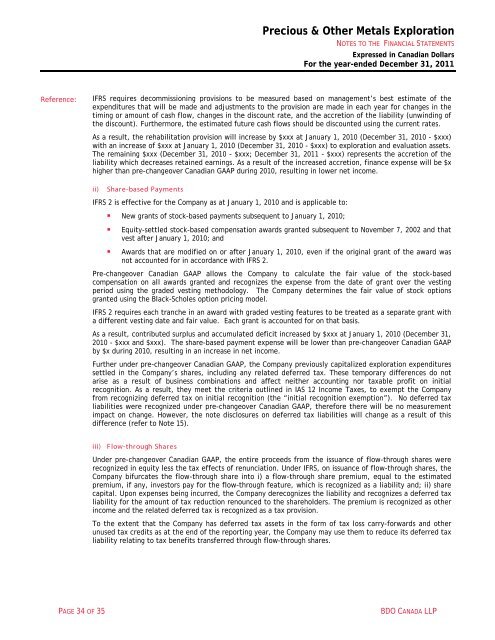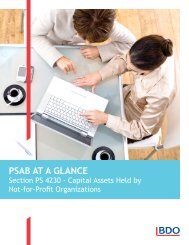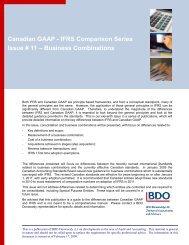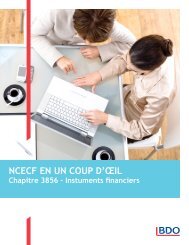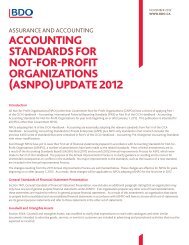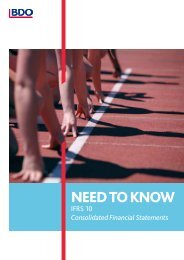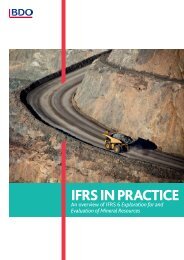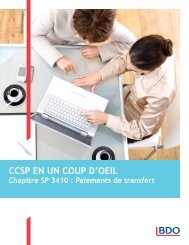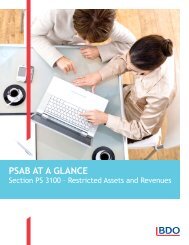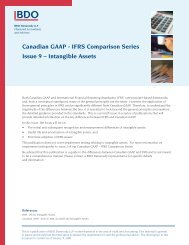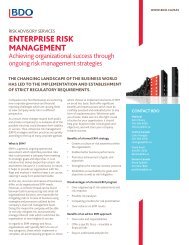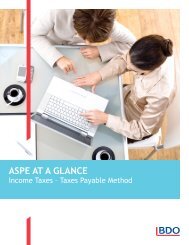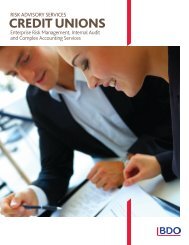2011 Annual Illustrative IFRS Financial Statements - BDO Canada
2011 Annual Illustrative IFRS Financial Statements - BDO Canada
2011 Annual Illustrative IFRS Financial Statements - BDO Canada
- No tags were found...
Create successful ePaper yourself
Turn your PDF publications into a flip-book with our unique Google optimized e-Paper software.
Precious & Other Metals ExplorationNOTES TO THE FINANCIAL STATEMENTSExpressed in Canadian DollarsFor the year-ended December 31, <strong>2011</strong>Reference:<strong>IFRS</strong> requires decommissioning provisions to be measured based on management’s best estimate of theexpenditures that will be made and adjustments to the provision are made in each year for changes in thetiming or amount of cash flow, changes in the discount rate, and the accretion of the liability (unwinding ofthe discount). Furthermore, the estimated future cash flows should be discounted using the current rates.As a result, the rehabilitation provision will increase by $xxx at January 1, 2010 (December 31, 2010 - $xxx)with an increase of $xxx at January 1, 2010 (December 31, 2010 - $xxx) to exploration and evaluation assets.The remaining $xxx (December 31, 2010 - $xxx; December 31, <strong>2011</strong> - $xxx) represents the accretion of theliability which decreases retained earnings. As a result of the increased accretion, finance expense will be $xhigher than pre-changeover Canadian GAAP during 2010, resulting in lower net income.ii)Share-based Payments<strong>IFRS</strong> 2 is effective for the Company as at January 1, 2010 and is applicable to:• New grants of stock-based payments subsequent to January 1, 2010;• Equity-settled stock-based compensation awards granted subsequent to November 7, 2002 and thatvest after January 1, 2010; and• Awards that are modified on or after January 1, 2010, even if the original grant of the award wasnot accounted for in accordance with <strong>IFRS</strong> 2.Pre-changeover Canadian GAAP allows the Company to calculate the fair value of the stock-basedcompensation on all awards granted and recognizes the expense from the date of grant over the vestingperiod using the graded vesting methodology. The Company determines the fair value of stock optionsgranted using the Black-Scholes option pricing model.<strong>IFRS</strong> 2 requires each tranche in an award with graded vesting features to be treated as a separate grant witha different vesting date and fair value. Each grant is accounted for on that basis.As a result, contributed surplus and accumulated deficit increased by $xxx at January 1, 2010 (December 31,2010 - $xxx and $xxx). The share-based payment expense will be lower than pre-changeover Canadian GAAPby $x during 2010, resulting in an increase in net income.Further under pre-changeover Canadian GAAP, the Company previously capitalized exploration expendituressettled in the Company’s shares, including any related deferred tax. These temporary differences do notarise as a result of business combinations and affect neither accounting nor taxable profit on initialrecognition. As a result, they meet the criteria outlined in IAS 12 Income Taxes, to exempt the Companyfrom recognizing deferred tax on initial recognition (the “initial recognition exemption”). No deferred taxliabilities were recognized under pre-changeover Canadian GAAP, therefore there will be no measurementimpact on change. However, the note disclosures on deferred tax liabilities will change as a result of thisdifference (refer to Note 15).iii) Flow-through SharesUnder pre-changeover Canadian GAAP, the entire proceeds from the issuance of flow-through shares wererecognized in equity less the tax effects of renunciation. Under <strong>IFRS</strong>, on issuance of flow-through shares, theCompany bifurcates the flow-through share into i) a flow-through share premium, equal to the estimatedpremium, if any, investors pay for the flow-through feature, which is recognized as a liability and; ii) sharecapital. Upon expenses being incurred, the Company derecognizes the liability and recognizes a deferred taxliability for the amount of tax reduction renounced to the shareholders. The premium is recognized as otherincome and the related deferred tax is recognized as a tax provision.To the extent that the Company has deferred tax assets in the form of tax loss carry-forwards and otherunused tax credits as at the end of the reporting year, the Company may use them to reduce its deferred taxliability relating to tax benefits transferred through flow-through shares.PAGE 34 OF 35<strong>BDO</strong> CANADA LLP


